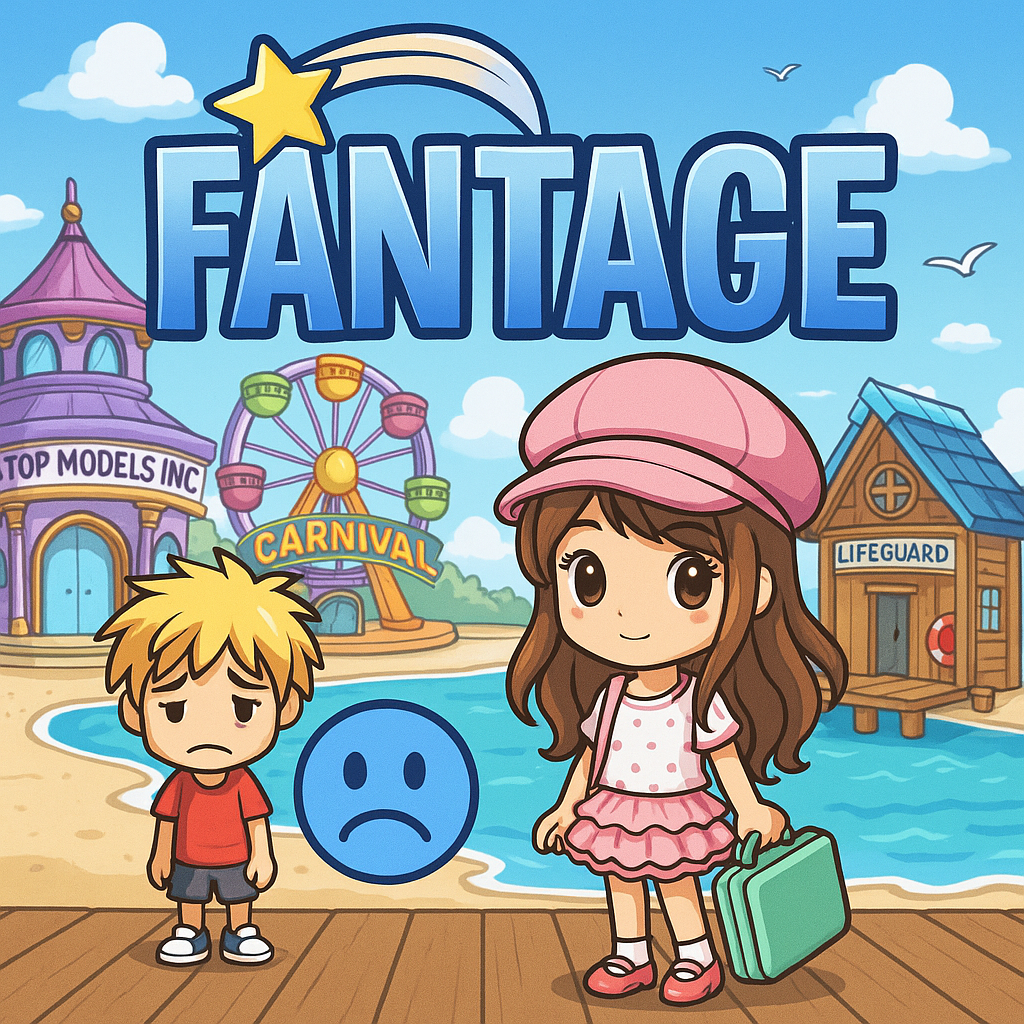Blog
The Untold Secret of Fantage’s Shutdown

The Untold Secret of Fantage’s Shutdown: Why Your Childhood World Vanished?
Introduction
The Untold Secret of Fantage’s Shutdown :Picture a vibrant virtual world that lit up your childhood with joy, only to fade into silence. Fantage, the beloved online haven of the 2000s for kids, shut down in July 2018. With its anime-style avatars, customizable outfits, and addictive mini-games like fishing and treasure hunts, it captivated millions worldwide. But why did Fantage shut down? In July 2025, seven years after its closure, the nostalgia burns bright among former players. This article peels back the layers of this mystery, exploring its rich history, the hidden reasons for its demise, and the enduring legacy that keeps it alive in our hearts. Get ready to dive into a journey of discovery!
Fantage History: The Birth of a Legend
Fantage launched in March 2008 by Fantage Inc., founded by David Hwang and Peter Bae, targeting kids aged 6 to 16. This virtual world stood out with its colorful districts—Downtown with its bustling shops, Carnival with its thrilling rides, and the serene Beach where players could relax. The game’s core was its avatar customization, allowing kids to design unique looks with coins earned from mini-games like Top Models Inc., where they ran virtual fashion shows, or Pet Town, where they cared for digital pets. By 2014, it boasted over 30 million registered users, a testament to its global appeal.
The journey began with an educational intent, but negative feedback from young users shifted its focus to a social platform. A pivotal moment came in 2010 when Nexon, a South Korean gaming giant, invested heavily, acquiring a 58.6% stake. This partnership fueled expansions like new areas and seasonal events, such as Halloween parties with spooky decorations. Fantage wasn’t just a game; it was a cultural phenomenon, shaping how kids interacted online with its strict chat filters ensuring safety. Yet, beneath this success lurked challenges that would eventually lead to its end. What made this game a childhood staple, and how did its early promise unravel?
The Shutdown Date: June 30, 2018
The end came with an announcement on May 17, 2018, stating Fantage would cease operations on June 30, 2018. Servers officially shut down at 12:36 AM EST on July 1, 2018, marking the end of an era. To bid farewell, Fantage hosted a “goodbye party” from May 17 to 23, 2018, featuring special events and free items. From June 1 to 30, all players received free membership, a final gift to its loyal community. The suddenness shocked fans, leaving many wondering what went wrong.
What triggered this abrupt closure? The absence of a detailed statement from Fantage Inc. sparked a wave of speculation. Was it a business decision, a technical limitation, or something else? Let’s explore the factors that sealed Fantage’s fate.
Reason 1: Financial Struggles and Debt
Financial woes were a silent killer for Fantage. Reports indicate a staggering $5.7 million debt accumulated between 2013 and 2018, draining its resources. The introduction of Trade-N-Sell, a feature allowing players to trade virtual items, backfired spectacularly. It disrupted the in-game economy, making it easier to sell ecoins outside the official system, which slashed membership revenue—a key income source. The 2017 split from Nexon, which had been a financial lifeline, left Fantage vulnerable. Without a major investor, the company couldn’t cover operational costs or debts, forcing the shutdown.
How did this debt spiral out of control? Poor financial management, coupled with a failure to modernize the game, inflated expenses. This serves as a cautionary tale for gaming startups, highlighting the need for sustainable revenue models. Could a different strategy have saved it?
Reason 2: The End of Adobe Flash
Fantage’s reliance on Adobe Flash proved its Achilles’ heel. Flash, the backbone of early online games, was slated for discontinuation on December 31, 2020, due to security vulnerabilities. Hacks, such as manually adding Gold to accounts, exposed these weaknesses, eroding player trust. Migrating to a new platform like HTML5 was an option, but the cost and time required were prohibitive. Without this transition, Fantage couldn’t survive the tech shift.
Why didn’t they adapt? The expense, estimated at millions, and the lengthy development process likely deterred the company. This closure mirrors the fate of other Flash-based games, signaling the end of an era in gaming technology. What lessons can today’s developers draw from this?
Reason 3: Declining Popularity and Demographic Shift
By late 2016, Fantage’s core audience—kids of the early 2000s—had grown into teenagers and young adults, migrating to platforms like Discord, Roblox, and Fortnite. The removal of popular features like Trade-N-Sell and MyMall, where players shopped for virtual goods, alienated remaining users. With a peak of 30 million users in 2014, active players had significantly dropped by 2018, reflecting a shift in gaming trends toward more dynamic, free-to-play models.
Why did its charm fade? Stiff competition and a lack of innovation left Fantage outdated. The rise of mobile gaming also played a role, as Fantage struggled to adapt beyond its PC roots. How did this demographic change reshape the online gaming landscape?
Community Response: Grief and Revival Attempts
The shutdown sparked a wave of grief among players. Petitions like “Save Fantage” on Change.org garnered 244 signatures, pleading for a revival. Fans launched private servers, such as Fantage Legacy, to recreate the experience, complete with nostalgic maps and mini-games. One player, a 25-year-old from California, shared on X in 2018, “Fantage was my escape; losing it feels like losing a friend.” However, Fantage Inc.’s legal threats shut down these efforts, citing copyright infringement.
Another attempt, Pixel Park, emerged as a spiritual successor in 2019, promising a similar avatar-based world. Funded through crowdfunding, it raised $50,000 but collapsed in April 2020 due to insufficient resources and poor management. These failures highlight the challenges of reviving a beloved game without official support. How did this community spirit reflect the game’s impact?
Fantage’s Legacy: Memories That Endure
Though Fantage is gone, its legacy thrives in the hearts of millions. X posts in 2025 still reminisce about “the good old days,” with users sharing screenshots of their avatars. The 2022 launch of LeShop Fashion Designer by MSI Lab, a former Fantage branch, attempts to recapture the magic. This mobile app lets players design avatars and host fashion shows, echoing Fantage’s creative spirit. With over 500,000 downloads by 2025, it’s a partial revival, though it lacks the full community feel.
What endures from Fantage? The friendships forged online and the creative freedom it offered remain its true gifts. Nostalgia drives trends like retro gaming nights on Twitch, where players recreate Fantage experiences. How has this game influenced today’s digital culture?
Deep Dive: Lessons for the Future
Fantage’s shutdown offers valuable lessons. Innovation is critical—failing to adapt to HTML5 or mobile platforms sealed its fate. The $5.7 million debt underscores the need for robust financial planning, a pitfall seen in other closures like Club Penguin’s 2017 shutdown, which faced similar economic pressures. Startups must balance community engagement with profitability to avoid such ends.
What could have changed the outcome? Early investment in modern tech, regular updates, and a mobile app might have kept Fantage relevant. Comparing it to Roblox’s success—adapting to trends with frequent content drops—highlights missed opportunities. What can the gaming industry learn moving forward?
Practical Tips for Nostalgia Fans
To relive the magic, try these:
- Explore archives: Check Fantage Archives for old screenshots.
- Watch videos: Search YouTube for mini-game walkthroughs.
- Join discussions: Follow #Fantage on X for fan stories.
- Try the app: Download LeShop from the app store.
Challenge: Try one. What emotions did it evoke?
Frequently Asked Questions (FAQ)
Why did Fantage shut down?
Due to debt, Flash obsolescence, and declining popularity.
When did it close?
July 1, 2018.
Are there private servers?
No, legal actions stopped efforts like Fantage Legacy.
What is LeShop?
A mobile app reviving Fantage’s fashion and avatar features.
How many users did it have?
Over 30 million by 2014.
Where can I learn more?
Visit X or fan archives for details.
Conclusion
The untold secret of Fantage’s shutdown is unveiled: a deadly mix of financial debt, the end of Adobe Flash, and a shifting player base brought down your childhood world. Yet, its legacy lives on through nostalgia and efforts like LeShop. In 2025, Fantage still warms the hearts of millions. What memory of Fantage do you hold dear?
Take action: Share your thoughts or favorite Fantage moment in the comments! Let’s keep the nostalgia alive!








